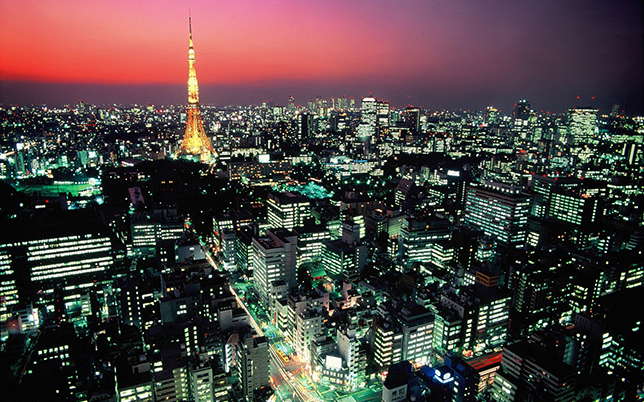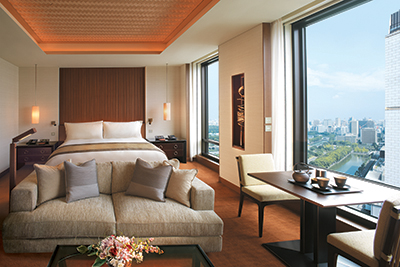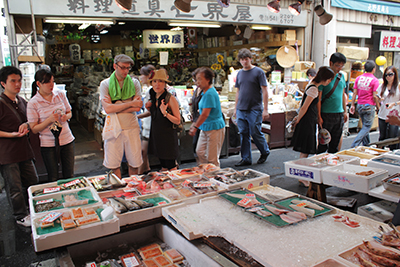
Lost in Translation captures both the enthralling allure and mysteriousness of Tokyo for uninitiated Westerners. Though it has been 10 years since the film’s premiere, it still holds up: Buzzing neighborhoods plastered with glowing signs and thick with crowds overload your senses. English signage is sparse, cab drivers many times don’t know where they are going and true to the film’s title, a lot of exchanges do get lost in translation, all of which makes it difficult to navigate through the city. But however you manage to get around, there’s much to love about the exciting metropolis, especially as it gears up as the site of the 2020 Summer Olympics. Here’s our guide to spending two days in Tokyo in style.
Start your luxe trip by checking into The Peninsula Tokyo. Overlooking the Imperial Palace gardens and Hibiya Park, the spacious rooms (among the largest in the city) have a modern, airy Japanese design with sliding horse chestnut doors, red lacquer desks and ceilings covered in hand-woven cedar panels. Of course, the brand always delivers on tech perks, including electronic nail dryers, control panels that tell you everything from the outside humidity to the direction the wind is blowing, personal fax machines and numbers, and bathrooms with flat-screens and electronic toilets. The hotel provides make-it-happen service, an ESPA spa and the dark, sexy Peter grill on the 24th floor with floor-to-ceiling windows, rich wood and curvy black banquettes.
The sleek and stylish Mandarin Oriental, Tokyo also offers top-notch amenities—Cantonese restaurant Sense is jam-packed during weekend dim sum, the eight-seat Tapas Molecular Bar serves avant-garde tasting menus and the 37th-floor spa’s romantic suites allow you to gaze at the skyline while getting a massage. The rooms are equally chic, especially the gray marble bathrooms, where you can bathe in the deep tubs while soaking in a view of the city. Be sure to ransack the bathroom’s big black lacquer box for Apivita face wash and lip balm, hair bands and a brush.
Wherever you choose to stay, begin your first day at Mandarin’s Oriental Lounge. Order the eggs Benedict (it’s part of the Power Breakfast that also includes a blueberry muffin, pineapple and fresh squeezed juice) stuffed with fresh crab from the famous Tsukiji fish market. Cut into the Benedict and a slightly sweet red yolk seeps out—the hue is a result of the chickens’ strict hibiscus and rose diet. Pair it with the excellent Mandarin Oriental Blend tea, a flavorful Chinese oolong with notes of lychee.
For a dramatic look at the city, head to Urayasu Heliport to take a helicopter ride. Excel Air Service’s Tokyo Sky Cruise lasts only 15 minutes, but it’s worth it: The two-engine chopper gives you an unrivaled perspective of landmarks such as the red-and-white Eiffel-like Tokyo Tower and the new 2,080-foot Tokyo Skytree, the world’s tallest free-standing broadcasting tower. You must arrive at least 30 minutes before your scheduled departure, but it’s easy to while away time sitting on the navy semicircular sofas in the waiting room, listening to soft jazz and sipping Dom Pérignon. Or get fresh air and views of the water and nearby Tokyo Disney out on the terrace.
After an exhilarating ride, take it easy with some shopping in Ginza, the city’s fashion center. There, you’ll find all of the top labels — Chanel, Bvlgari, Gucci — but don’t miss the department stores. The multi-story megastores especially impress with their tucked-away basement food halls, where you can find stalls filled with everything from tempura to truffles. Matsuya Ginza offers two floors of food; the B2 level is more like a grocery store, while B1 holds the food stalls (one of which has an open counter space where we watched a chef decorate a chocolate cake). But explore Matsuya’s other nine floors (including a golf school on the rooftop terrace) and pick up one of Issey Miyake’s fun geometric Bao Bao bags that resemble moldable Rubik’s cubes. Next to Mandarin Oriental, Tokyo sits the sprawling Mitsukoshi Nihonbashi, Japan’s oldest department store, which also has floors upon floors of goods. Check out the theater on the sixth floor, Japanese crafts on the eighth and follow the crowds on B2 stocking up on bread and pastries at Johan Paris. If you feel daunted by the maze, Mitsukoshi offers shopping consultants who can also assist with any language barriers.
Don’t overdo it on the snacking, since you’ll head to Roppongi for lunch at The Ritz-Carlton, Tokyo’s Azure 45. The French seafood spot provides just the right post-shopping menu: The five-course Ladies Luxury Lunch includes a light potato soup with leeks; fresh yellowtail and geoduck clam carpaccio with a tomato and avocado tartine; tender, pan-fried Japanese Wagyu beef with red wine sauce; and, of course, a glass of the hotel’s own private label cuvée. Sip the champagne while enjoying the surrounding views and Tokyo Tower out of the wall of windows.
After lunch, round out your shopping with a visit to Tokyo’s nerdy anime and electronics district, Akihabara. But we aren’t sending you to the loud, bright area for Sailor Moon dolls and robots; hidden underneath the JR train tracks is 2k540 Aki-Oka Artisan, a modern, white-filled mall with quiet shops. What makes this small cluster of stores stand out is that it carries made-in-Japan goods, which are actually hard to find in the city. Visit Miyabica, a jeweler that crafts pendants, rings and more with colorful urushi, or Japanese lacquer; Litsta for small handmade leather satchels; and Nocra woodshop for engraved clocks and business card holders. On your way out, stop at the table in front of Soshin Kaleidoscopes to watch an artisan create the custom toys by hand.
Bring your shopping treasures back to the hotel and relax before heading to Conrad Tokyo’s Kazahana for kaiseki, a traditional multi-course Japanese dinner (if you’re still full from lunch, order from the sushi menu instead). Expect courses of super-fresh sashimi; bonito, squid, yellowtail and horse mackerel sushi; a seasonal offering (we loved the artfully plated dish of chestnuts, slightly bitter ginkgo nuts, salmon roe and more with maroon and green leaves adorning it); and a light tofu cheesecake. If you want a nightcap, head over to the sophisticated TwentyEight on the Conrad’s 28th floor for a martini and fantastic city panoramas, thanks to the floor-to-ceiling windows. But don’t stay too long—tomorrow starts before the sun rises.
Tsukiji, Japan’s largest wholesale market, is one of Tokyo’s most popular attractions. It’s a feast for the eyes and the stomach, as you find cartons overflowing with pink pearls of salmon roe, tentacles and every fish you can imagine. The inner market is an experience in itself and the big thing to see is the tuna auction. However, only 120 tickets are given around 5 a.m. daily, so visitors line up as early as 3 a.m. The best way to navigate the auction and the market is to employ the self-described “Tokyo Fixer,” Shinji Nohara, an in-demand local culinary insider who can wait in line for you and ensure you a ticket. Plus, he’ll tour you around the sprawling market and show you the best places to shop and dine. While you’re at Tsukiji, also peruse the outer market, made up of rows of specialty shops, for a breakfast of ramen or tamagoyaki, a dense, rectangular Japanese omelet made of layers of cooked egg that you’ll see people eating on a stick.
Save room for lunch at Tokyo Shiba Toufuya-Ukai, a traditional restaurant that’s a stark contrast with its neighbor, the modern Tokyo Tower. The upscale restaurant is known for its tofu dishes, but its 71,000-square-foot Japanese garden is just as much of a draw. The peaceful setting is a welcome respite after weaving between the speedy mini trucks at the hectic market. Before sitting down in your tatami room (where you’ll likely have a view of the garden), explore the courtyard’s verdant grounds, red bridge and pond teeming with koi in brilliant shades of gold and red orange. Then enjoy a kaiseki that can include squares of deep-fried tofu with a splash of miso, sashimi, a simmered meatball made of crab and fried tofu, and for a not-too-sugary dessert, a sweet adzuki bean soup with a mochi-like treat floating on top.
Next, do some sightseeing in bustling Asakusa. The district swells with people coming to Sensō -ji Temple to worship Kannon, the goddess of mercy. Even those who aren’t coming to pray will be struck by the scene: A larger-than-life red lantern hangs from the gate flanked by smaller black-and-gold lanterns while massive straw sandals are attached to the back walls, a pagoda sits in the background and incense wafts from a large pot in front of the temple. If the setting inspires you, head inside the temple to draw an o-mikuji, a fortune. Donate some change, gently shake a box of wooden sticks and pull one out. Note the stick’s number, return it to the box and find the drawer matching your number, where your future awaits. On your way out, peruse the vendors on Nakamise-dōri, one of the oldest shopping streets in the country, just outside of the temple. The street is very touristy, but it’s fun for first-timers to peek inside the open-air stalls to see wood-block prints, chopsticks and freshly roasted rice crackers.
The best way to end your two days in Tokyo is where Lost in Translation was set—Park Hyatt Tokyo. Head to the 52nd floor of the hotel for dramatic city views out of the floor-to-ceiling windows and dinner at the famed New York Grill. Order the rich, buttery Kobe beef; it will make American versions taste like lackluster imitations. After dinner, visit the adjacent New York Bar to hear the nightly live jazz over a glass of Radio City (Earl Grey-infused Belvedere, pink pepper syrup and soda) or Suntory’s Hibiki 21-year-old whisky. As Bill Murray says in the film, “For relaxing times, make it Suntory time.” Then linger to take in vistas of the neon-filled wonder of a city.
Photos Courtesy of TCVB and VFM Leonardo Inc



